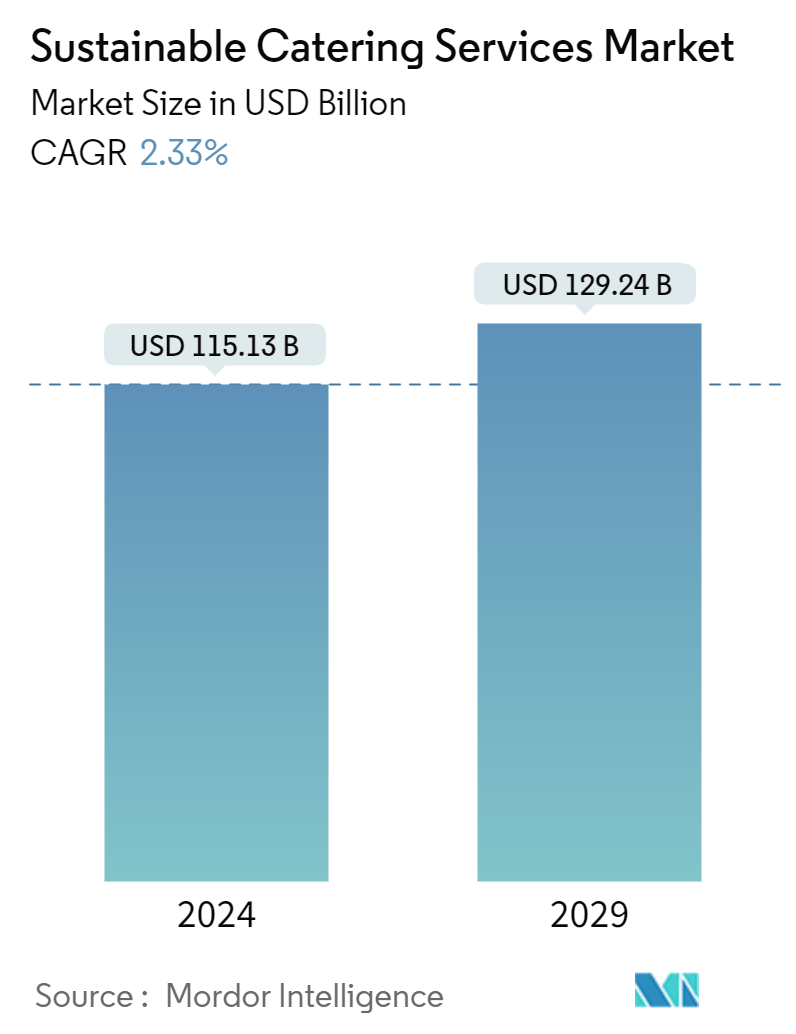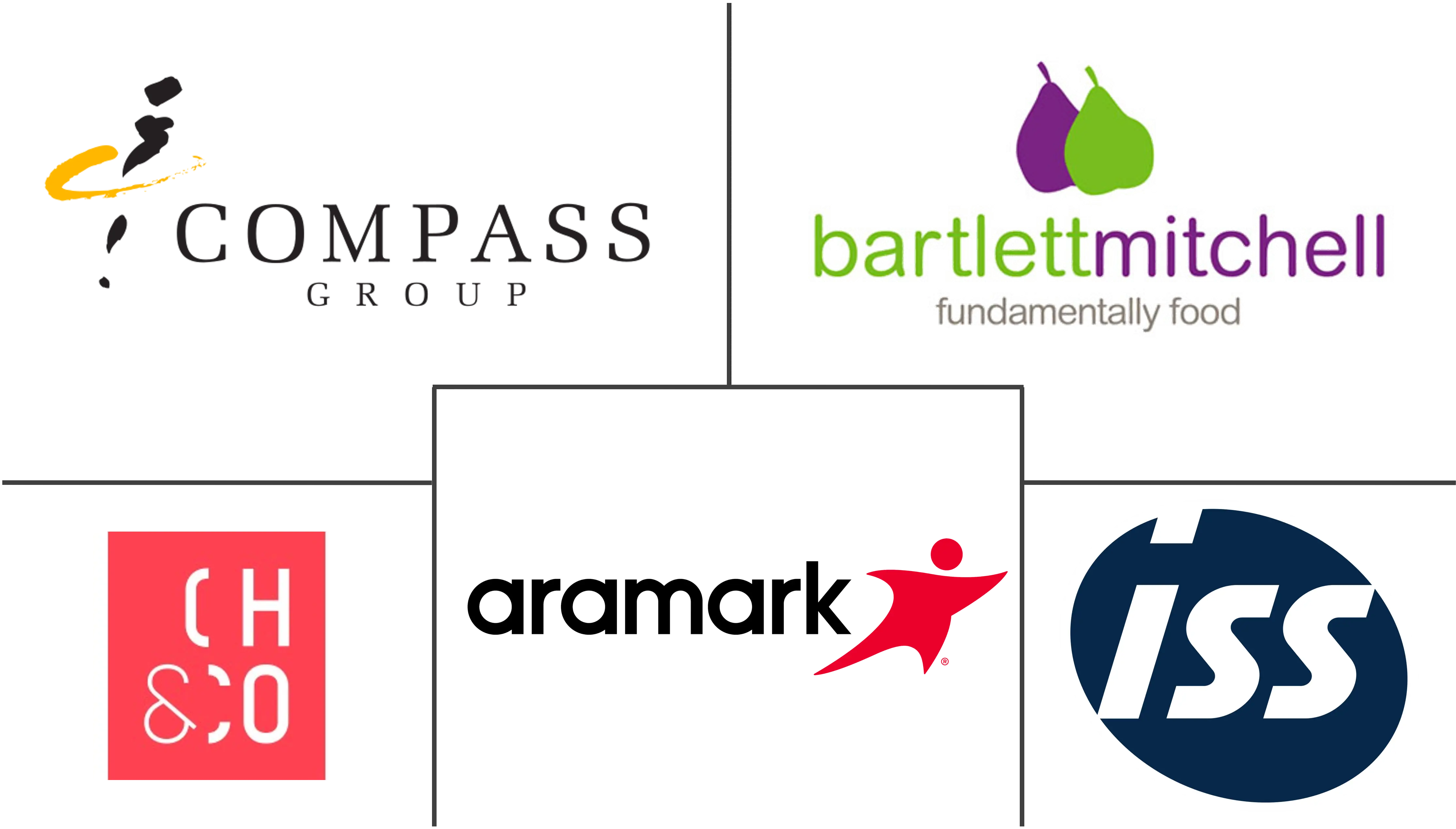Market Size of Sustainable Catering Services Industry

| Study Period | 2020 - 2029 |
| Market Size (2024) | USD 115.13 Billion |
| Market Size (2029) | USD 129.24 Billion |
| CAGR (2024 - 2029) | 2.33 % |
| Fastest Growing Market | Asia Pacific |
| Largest Market | North America |
| Market Concentration | Medium |
Major Players
*Disclaimer: Major Players sorted in no particular order |
Sustainable Catering Services Market Analysis
The Sustainable Catering Services Market size is estimated at USD 115.13 billion in 2024, and is expected to reach USD 129.24 billion by 2029, growing at a CAGR of 2.33% during the forecast period (2024-2029).
Sustainability caterers are allowed to create and implement eco-friendly processes. It reduces waste products through both manufacturing and real-world use. When resources are used responsibly, they will always be present. Social trends indicate that consumers are becoming more conscious of the environmental effects of their products.
Environmental concerns are rising, and more and more businesses are looking for ways to reduce their environmental impact while increasing efficiency and productivity. Eco-friendly catering equipment leads the way in reducing waste, saving resources, and encouraging sustainable practices in the catering world. Like many other industries, the catering industry faces several environmental issues. From food wastage and energy consumption to water usage and single-use packaging, there are a variety of ways in which catering impacts the environment. Realizing the importance of addressing these issues, many catering companies are adopting eco-friendly processes and equipment.
The most significant benefit of environmentally friendly catering equipment is its energy efficiency. Energy-efficient appliances use less energy while in use, which means lower utility bills and lower emissions of greenhouse gases. Energy-efficient equipment often includes improved insulation, heat retention, and optimized cooking processes.
Sustainable Catering Services Industry Segmentation
Sustainable catering refers to the practice of selecting foods that are beneficial for both human health and the environment. The sustainable catering services market is segmented by service type, event type, end-user, and region. By service type, the market is segmented into contractual catering services, non-contractual catering services, and other catering services (buffet services, etc). By event type, the market is segmented into corporate, wedding, social events, and others (restaurant catering, etc). By end-user, the market is segmented into individuals, hospitality, educational, healthcare, in-flight, and other end users (ship catering, etc). And by region, the market is segmented into North America, South America, Europe, Asia-Pacific, and the Middle East and Africa. The report offers market size and forecast of the sustainable catering services market for all the above segments in value (USD).
| By Service Type | |
| Contractual Catering Services | |
| Non-Contractual Catering Services | |
| Other Catering Services |
| By Event Type | |
| Corporate | |
| Wedding | |
| Social Events | |
| Others |
| By End-User | |
| Individuals | |
| Hospitality | |
| Educational | |
| Healthcare | |
| In-Flight | |
| Other End Users |
| North America | |
| United States | |
| Canada | |
| Mexico | |
| Rest of North America |
| Europe | |
| United Kingdom | |
| Germany | |
| France | |
| Russia | |
| Italy | |
| Spain | |
| Rest of Europe |
| Asia-Pacific | |
| India | |
| China | |
| Japan | |
| Australia | |
| Rest of Asia-Pacific |
| South America | |
| Brazil | |
| Argentina | |
| Rest of South America |
| Middle-East and Africa | |
| United Arab Emirates | |
| South Africa | |
| Rest of Middle-East and Africa |
Sustainable Catering Services Market Size Summary
The sustainable catering services market is experiencing a notable shift towards eco-friendly practices, driven by increasing consumer awareness and demand for environmentally responsible options. This industry is focused on reducing waste and minimizing environmental impact through the adoption of sustainable processes and equipment. Catering companies are increasingly incorporating energy-efficient appliances, which not only lower utility costs but also reduce greenhouse gas emissions. The trend towards organic produce is also gaining momentum, with consumers, particularly millennials, favoring organic foods for their perceived health benefits and environmental safety. This shift has prompted caterers to source locally grown organic ingredients, use eco-friendly packaging, and implement waste reduction strategies, aligning their offerings with the growing preference for healthier and more sustainable food choices.
In the Asia-Pacific region, the demand for sustainable catering services is on the rise, fueled by population growth and the expansion of the organized sector. China is leading this trend, particularly in the inflight catering market, supported by its burgeoning aviation industry. The plant protein sector is also witnessing rapid growth, driven by health-conscious consumers and increased awareness of environmental issues. The market is moderately fragmented, with key players like Aramark Corp., Compass Group PLC, and others adopting strategies that emphasize local sourcing and sustainable packaging. Recent acquisitions and partnerships, such as Compass Group's acquisition of CH&CO and Aramark's agreement with Bean Sprouts, highlight the industry's commitment to expanding its sustainable offerings and enhancing its market presence.
Sustainable Catering Services Market Size - Table of Contents
-
1. MARKET DYNAMICS
-
1.1 Market Overview
-
1.2 Market Drivers
-
1.2.1 Increasing Trend of Outsourcing Food Services
-
1.2.2 Growing Popularity of Social Events
-
-
1.3 Market Restraints
-
1.3.1 Challenges in Sourcing Organic and Local Ingredients
-
1.3.2 Limited Consumer Awareness and Understanding of Sustainable Catering Practices
-
-
1.4 Market Opportunities
-
1.4.1 Increasing Consumer Demand for Healthier Food Options
-
1.4.2 Rising Demand for Catering Services at Events
-
-
1.5 Porter's Five Forces Analysis
-
1.5.1 Threat of New Entrants
-
1.5.2 Bargaining Power of Buyers/Consumers
-
1.5.3 Bargaining Power of Suppliers
-
1.5.4 Threat of Substitute Products
-
1.5.5 Intensity of Competitive Rivalry
-
-
1.6 Insights on Technological Advancements in the Market
-
1.7 Impact of COVID-19 on the Market
-
-
2. MARKET SEGMENTATION
-
2.1 By Service Type
-
2.1.1 Contractual Catering Services
-
2.1.2 Non-Contractual Catering Services
-
2.1.3 Other Catering Services
-
-
2.2 By Event Type
-
2.2.1 Corporate
-
2.2.2 Wedding
-
2.2.3 Social Events
-
2.2.4 Others
-
-
2.3 By End-User
-
2.3.1 Individuals
-
2.3.2 Hospitality
-
2.3.3 Educational
-
2.3.4 Healthcare
-
2.3.5 In-Flight
-
2.3.6 Other End Users
-
-
2.4 By Geography
-
2.5 North America
-
2.5.1 United States
-
2.5.2 Canada
-
2.5.3 Mexico
-
2.5.4 Rest of North America
-
-
2.6 Europe
-
2.6.1 United Kingdom
-
2.6.2 Germany
-
2.6.3 France
-
2.6.4 Russia
-
2.6.5 Italy
-
2.6.6 Spain
-
2.6.7 Rest of Europe
-
-
2.7 Asia-Pacific
-
2.7.1 India
-
2.7.2 China
-
2.7.3 Japan
-
2.7.4 Australia
-
2.7.5 Rest of Asia-Pacific
-
-
2.8 South America
-
2.8.1 Brazil
-
2.8.2 Argentina
-
2.8.3 Rest of South America
-
-
2.9 Middle-East and Africa
-
2.9.1 United Arab Emirates
-
2.9.2 South Africa
-
2.9.3 Rest of Middle-East and Africa
-
-
Sustainable Catering Services Market Size FAQs
How big is the Sustainable Catering Services Market?
The Sustainable Catering Services Market size is expected to reach USD 115.13 billion in 2024 and grow at a CAGR of 2.33% to reach USD 129.24 billion by 2029.
What is the current Sustainable Catering Services Market size?
In 2024, the Sustainable Catering Services Market size is expected to reach USD 115.13 billion.

